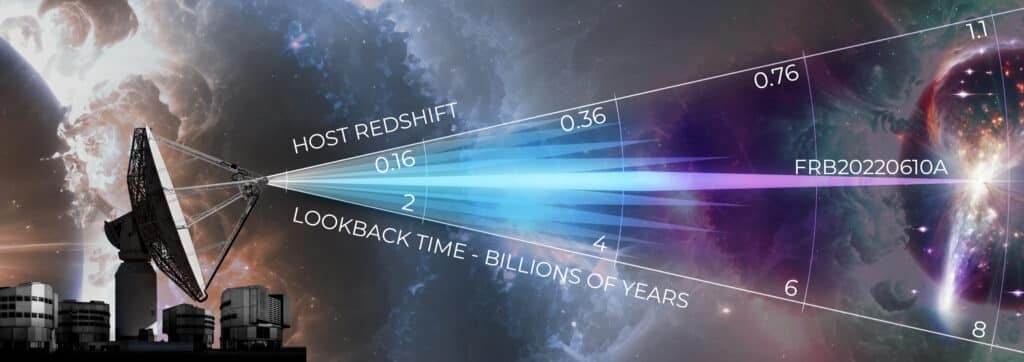Maunakea, Hawaiʻi – Scientists have discovered an eight-billion-year-old fast radio burst (FRB) – the most ancient and distant located to date.
A global team that includes UC Santa Cruz Professor of Astronomy J. Xavier Prochaska, an expert in spectroscopy, and was led by Macquarie University’s Stuart Ryder and Swinburne University of Technology’s Associate Professor Ryan Shannon reported on their discovery in a paper published today in the journal Science. This FRB smashes the team’s previous distance record by 50 percent.
The discovery was made using Australia’s Commonwealth Scientific and Industrial Research Organisation’s (ASKAP) radio telescope in Western Australia and the European Southern Observatory’s optical Very Large Telescope (VLT) in Chile. The Keck Observatory on Maunakea, Hawaiʻi was used to obtain images of the host galaxy system at other wavelengths that helped the scientists to model the history of star formation in the host galaxy system.
ASKAP detected the burst, named FRB 20220610A, on June 10, 2022. It was created in a cosmic event that released, in milliseconds, the equivalent of our Sun’s total emission over 30 years. ASKAP was used to determine precisely where the burst originated, and the VLT enabled the team to search for the host galaxy.
The source of the burst was shown to be a group of two or three galaxies that are merging, supporting current theories on the cause of fast radio bursts. The team also showed that eight billion years is about as far back as we can expect to see and pinpoint fast radio bursts with current telescopes.
FRBs are a key science interest for the SKA Observatory (SKAO), an international group of institutions working to build the two largest radio telescope arrays in the world. Authors of the paper include SKAO Postdoctoral Fellow Hao Qiu and several members of the SKAO’s Science Working Groups.

The study is a prime example of the new era of multi-wavelength astronomy, where facilities observing different types of light are used together to reveal more than they could do individually.
“Radio observations give us key information that allows us to measure the turbulent magnetized interstellar and intergalactic medium between us and the host galaxy,” Qui said. “Optical observations play a complementary role by enabling us to identify the distance of the host galaxy and learn more about the host and foreground environment along the line of sight. Comparing the radio and optical data allows us to test cosmological models of the intergalactic medium and better understand what could create these bursts.”
The paper confirms that FRBs are common events in the cosmos and can be used to measure the “missing” matter between galaxies, to better understand the structure of the universe.
“If we count up the amount of normal matter in the universe – the atoms that we are all made of – we find that more than half of what should be there today is missing. We think that the missing matter is hiding in the space between galaxies, but it may just be so hot and diffuse that it’s impossible to see using normal techniques,” Shannon said. “Fast radio bursts sense this ionized material. Even in space that is nearly perfectly empty they can ‘see’ all the electrons, and that allows us to measure how much stuff is between the galaxies.”
ASKAP is currently the best radio telescope to detect and locate FRBs, until the SKA telescopes (currently under construction in Australia and South Africa) come online.
“The SKA telescopes will be even more sensitive, which means we will be able to search for fainter FRBs from further distances,” Qiu said. “Larger, more sensitive optical/infrared telescopes will be crucial to assist us in identifying these distant host galaxies.”
*CSIRO’s ASKAP radio telescope is an SKA precursor situated at Inyarrimanha Ilgari Bundara, the CSIRO Murchison Radio-astronomy Observatory, on Wajarri Yamaji Country in Western Australia.
ABOUT DEIMOS
The DEep Imaging and Multi-Object Spectrograph (DEIMOS) boasts the largest field of view (16.7arcmin by 5 arcmin) of any of the Keck Observatory instruments, and the largest number of pixels (64 Mpix). It is used primarily in its multi-object mode, obtaining simultaneous spectra of up to 130 galaxies or stars. Astronomers study fields of distant galaxies with DEIMOS, efficiently probing the most distant corners of the universe with high sensitivity.
ABOUT W. M. KECK OBSERVATORY
The W. M. Keck Observatory telescopes are among the most scientifically productive on Earth. The two 10-meter optical/infrared telescopes atop Maunakea on the Island of Hawaii feature a suite of advanced instruments including imagers, multi-object spectrographs, high-resolution spectrographs, integral-field spectrometers, and world-leading laser guide star adaptive optics systems. Some of the data presented herein were obtained at Keck Observatory, which is a private 501(c) 3 non-profit organization operated as a scientific partnership among the California Institute of Technology, the University of California, and the National Aeronautics and Space Administration. The Observatory was made possible by the generous financial support of the W. M. Keck Foundation. The authors wish to recognize and acknowledge the very significant cultural role and reverence that the summit of Maunakea has always had within the Native Hawaiian community. We are most fortunate to have the opportunity to conduct observations from this mountain.


